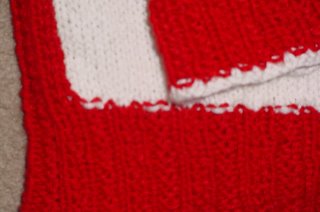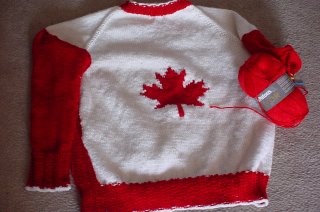My Olympic Sweater Technical Notes:
Knit with Patons Decor, 5 balls Winter White (main colour) and 2 balls Barn Red (contrast colour)
4.5 mm circular needle
I used the Single circular needle technique for whole sweater, including neckband and sleeves.
Guage:
Ladder Ribbing: 12 sts and 14 rows equals 2" on 4.5 mm needles, slightly stretched.
Stockinette: 10 sts and 13 rows equals 2" on 4.5 mm needles.
Sts:
Ladder Ribbing multiple of 6 sts.
row 1: K3 P3
row 2: K1 P1 across row.
This pattern is totally reversible, and is knit exactly the same when in the round, or on two needles.
Neckband:
Cast on 90 sts, with white, join round being careful that sts are not twisted. Start Ladder ribbing (multiple of 6 sts)row 1: K3, P3 across roundrow 2: K1, P1 across round.
Knit 11 rows, ending with row 1. Change to main colour.
Dividing round:
PM (place marker), K5, PM, k20, PM for center front, k20, PM, k5, k40.
Short Row portion:
Remembering to increase at either side of the markers on the public side of the sweater (I did this by knitting in the sts front and back, but a variety of sts will work, including M1), knit to within 15 sts of the center front marker, sl, sl, turn, yarn in front, wrap the first stitch loosely, yarn behind.
Purl around sweater to within 10 sts of the center front marker, sl, sl, turn, wrap the first stitch loosely. Knit to within 10 sts of center front marker, remembering to increase on either side of the markers placed for the sleeve increases, and picking up the wrap and knitting it with the slipped stitch when you come to it, sl, sl, turn.
Wrap first st, purl around to within 7 sts of center front marker (remembering to pick up and purl slipped stitch when you come to it), sl, sl, turn.
Wrap first st, knit around to within 5 sts of center marker, sl, sl, turn.
Wrap fist st, purl around to within 5 sts of center marker, sl, sl, turn.
Wrap first st, knit around, picking up any wrapped sts as you come to them, and increasing on either side of the markers as before.
Knit one row plain, checking that your sleeves have the same number of sts between marker. If they don't, then increase on this row only to make them match. (This was the only problem I had with the short rows.)
Yoke:
Continue alternating plain rows with increase rows until the sweater is 9" from the bottom of the neck band (or desired depth). You should be knitting one row plain, and then one row with increases on either side of markers.
Knit 3 rows plain before the divide for the sleeves.
Sleeve Dividing row:
Knit across first sleeve; place sleeve sts on holder, knit across body, and second sleeve, place sleeve on st. holder, knit across body sts. Break yarn.
Join for Body:
Attach contrast yarn, cast on 21 sts with invisible cast on, attach main colour, knit across body sts, drop and attach second ball of contrast yarn, cast on 21 sts with invisible cast on, attach second ball of wool for body, knit across sts, end yarn over, turn.
Purl back across body sts, wrap at colour change, p1 k1 across underarm panel, ending p1, wrap at colour change, purl across body sts, wrap at colour change, p1 k1 across underarm panel, ending, sl 1, p1 in yarn over, psso, yo, turn.
(Public row) Contrast portion: K3, place marker, p3, continue k3 p3 across panel, ending k3, wrap yarns at colour change, knit across body sts, wrap yarns at colour change, contrast panel k3 p3 across underarm panel ending k3, wrap yarns at colour change, knit across body sts, ending sl 1 k1 into yarn over, pss0, yo. Turn.
Continue in this manner until desired body length to ribbing. Mine is 13" long, with 2 1/2 " for ribbing, in pattern.
If desired, introduce the intarsia motif after the first two rounds of the body. The motif can also be duplicate stitched on afterwards if you are not feeling confident about the intarsia in the round technique.
Ribbing: At 13" or desired length before ribbing, change to contrast colour and Fireman rib pattern. Decrease 15 sts around body, or as many are needed to be decreased to have a multiple of 6 sts for ribbing, starting with K3 P3 row. Complete 10 repeats of pattern, ending with K1 P1 row . Change to main colour. K3 P3 around row. Bind off all sts purlwise.
Sleeves.
With contrast colour, pick up and knit all sleeve sts on holder, then pick up 21 sts along invisible cast on for the contrast colour panel. Join round. Continue sleeve, maintaining pattern for contrast panel at underarm, for 3" before beginning decreases. Decrease 1 st either side of the underarm pattern panel, every 6 rows, until 48 sts remain or desired sleeve length to ribbing has been reached. My sleeves are 15" long from the underarm pick up, before the ribbing. If there are more than 48 sts, decrease to 48 sts, ending the sleeve on a K1 P1 row of the panel. Change to Fireman rib pattern, knitting 14 repeats of pattern (28 rows, or 3") ending with a K1 P1 row. Change to main colour, and complete a K3 P3 round. Cast off purlwise.
Sew in all loose ends and block sweater.
Comments, after the fact:
I found the neckband was large, and could have been reduced 1-2 repeats of ribbing for comfort. This would also solve the very large sweater body issue, as it was 46" chest measurement. If I was making it for a man, I would make the sleeves larger by 3 sts between the increase rounds and at least 3 inches longer both in the body and the arms, for my darling husband. This would mean casting on 6 more sts to start. Still, it is a lovely, loose comfortable sweater for me.
ramblings from a fibre fashionista who loves knitting, sewing, fashion, doll making...
25 February 2006
Gold Medal Finish!

Kaffe: Well, Deborah, I think that this sweater has qualified for the Gold, don't you?
Deborah: Absolutely. The neck has a lovely back raise, and the short rows are barely visible. The underarm panels are lovely, and I particularly like the red sleeve detail. Shades of the Canadian flag.
The intarsia portion is impressive, particularly since this is the designer's first attempt at intarsia, let alone intarsia done in the round. Straight panel intarsia under the arms with ribbing detail adds to the interest of the sweater.


Gold Medal Sweater.

This picture is from Tuesday evening, just before the Flu hit our house in full force.
Wednesday: Mom, and both lovely daughters were home sick. Thursday: Mom still home, seeing double, and wavering while standing. Teaching--what is that?
Of course, anyone can knit while prone on couch between seeing double and running for the bathroom, right!?!
16 February 2006
Olympics Commentary

Kaffe Fasset: Well, Deborah, after two disheartening false starts, Beth seems to be picking up steam on her Olympic Knitting event. She has passed the sleeve divide, and is working at significant speed for the intarsia front portion of her Olympic challenge.
Deborah Newton: Yes, Kaffe. Beth is competing in the very challenging 'Design your own' category, for the Canadian Knitting Team. Her project is a top-down sweater, in her team colours, using Paton's winter white and deep red. Her sweater includes some very challenging elements, a definite step up in complexity for this long time knitting designer.
Kaffe: Tell us a little more about these elements, Deborah.
Deborah: Beth's sweater incorporates a significant self designed, center front intarsia portion, the maple leaf, as well as intarsia insets along the body and under the arms . She is using the 'intarsia in the round technique', a new personal challenge. She also significantly stepped up the complexity of the design by incorporating a totally reversible ribbing pattern known as Fireman's rib, or Ladder Ribbing. The neck also includes a short-row portion to raise the back of the sweater for comfort.
Technical Notes:
Patons Decor, Winter White and Deep Red for contrast.
4.5 mm needles
Single circular needle technique for whole sweater.
Neckband:
Cast on 90 sts, with white. Start Ladder ribbing (multiple of 6 sts)
row 1: K3, P3 across round
row 2: K1, P1 across round
Knit 11 rows, ending with row 1. Change to main colour.
Dividing round: PM (place marker), K5, PM, k20, PM for center front, k20, PM, k5, k40.
Technical notes to be continued...
Freeezing Rain Frustrations...
So, Southern Ontario is covered in snow, freezing rain, and rain. The universities in this area are closed--the last time this happened, I was in Teacher's college and the world stopped for three days. A great day to knit--only....
My knitting bag is sitting in my room at school which is CLOSED due to freezing rain! Ack!
I can't believe that I did that!
So, here I am starting on challenge number two: Lace and garter stitch Maple leaf dishcloth, coming up.
My knitting bag is sitting in my room at school which is CLOSED due to freezing rain! Ack!
I can't believe that I did that!
So, here I am starting on challenge number two: Lace and garter stitch Maple leaf dishcloth, coming up.
9 February 2006
Just joined the Knitting Olympic Team Canada
So, it is official. I now have to get yarn, and start swatching in earnest! One new sweater, and a dishcloth coming up...
Subscribe to:
Posts (Atom)